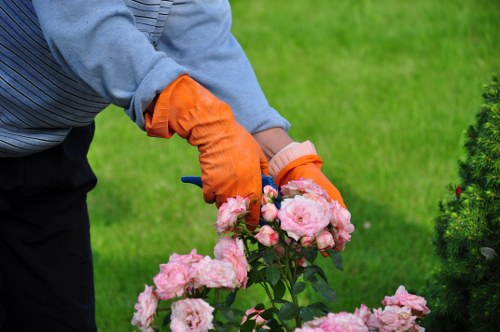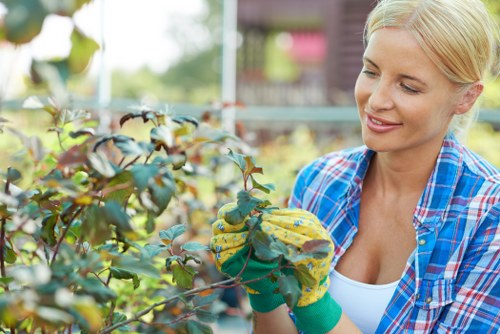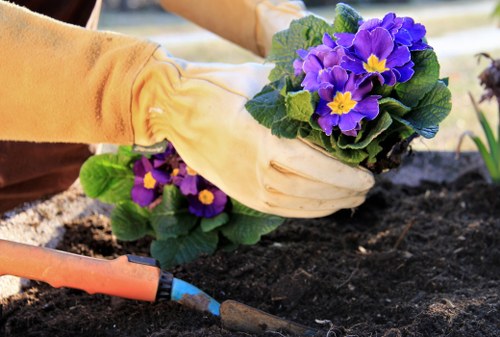Enhancing Your Landscape with Quality Garden Fencing
Introduction to Garden Fencing

Garden fencing plays a crucial role in landscape gardening, offering both functional and aesthetic benefits. Whether you're aiming to define boundaries, provide privacy, or add a decorative element to your outdoor space, selecting the right fence can transform your garden into a more enjoyable and secure environment.
In the realm of landscape gardening, fencing is not just a boundary marker but also an integral part of the overall design. It can influence the flow, structure, and visual appeal of your garden, making it essential to choose a style that complements your plants and garden layout.
With numerous materials, styles, and installation options available, understanding the different types of garden fencing can help you make an informed decision that aligns with your garden's needs and your personal preferences.
Types of Garden Fencing

There is a wide variety of garden fencing options, each offering unique advantages. Here are some of the most popular types:
- Wooden Fences: Classic and versatile, wooden fences can be customized in terms of height, color, and style.
- Metal Fences: Durable and low-maintenance, metal fences like wrought iron or aluminum offer a sleek look.
- Vinyl Fences: Known for their longevity and ease of cleaning, vinyl fences come in various styles and colors.
- Bamboo Fences: Eco-friendly and aesthetically pleasing, bamboo fences add a natural touch to gardens.
- Composite Fences: Combining wood fibers and plastic, composite fences offer durability with a natural appearance.
Each type of fencing material has its own set of benefits and drawbacks, making it important to consider factors like climate, maintenance, and budget when making your choice.
Choosing the Right Material for Your Garden Fence

Selecting the appropriate material is crucial for both the functionality and aesthetics of your garden fence. Here are some key considerations:
- Durability: Depending on your local climate, some materials may withstand weather conditions better than others. For instance, metal fences are resistant to warping, while wooden fences may require regular treatment.
- Maintenance: Consider how much time you're willing to invest in fence upkeep. Vinyl and metal fences generally require less maintenance compared to wood.
- Cost: Budget is always a factor. Wooden fences can be cost-effective initially but might incur higher maintenance costs over time.
- Style: The fence should complement the overall design of your garden. For a rustic look, wooden or bamboo fences are ideal, while metal or vinyl can offer a more modern aesthetic.
By evaluating these factors, you can choose a fencing material that not only fits your garden's needs but also enhances its beauty.
Design Ideas for Garden Fencing

Incorporating creative design elements into your garden fencing can elevate the visual appeal of your landscape. Here are some inspiring ideas:
Incorporate Plantings
Integrating climbing plants like ivy, roses, or jasmine with your fence can create a lush, green backdrop that adds texture and color to your garden.
Decorative Panels
Using decorative panels with intricate patterns or artistic designs can turn your fence into a statement piece, adding character and charm.
Lighting Features
Adding solar-powered lights or lanterns along your fence can enhance the ambiance of your garden, making it enchanting during the evening hours.

These design ideas not only enhance the beauty of your garden fencing but also contribute to the overall harmony and functionality of your outdoor space.
Installation Tips for Garden Fencing
Proper installation is key to ensuring your garden fence is both durable and visually appealing. Here are some essential tips to consider:
- Planning and Layout: Before installation, map out the fence line, ensuring it aligns with your garden's layout and design elements.
- Foundation and Anchoring: Ensure fences are securely anchored with appropriate foundations to withstand weather conditions and prevent shifting.
- Height and Spacing: Decide on the appropriate height based on privacy needs and the fence's purpose, and maintain consistent spacing between panels or slats for a uniform look.
- Permits and Regulations: Check local building codes and homeowners association guidelines to ensure compliance with fencing regulations.
Following these installation tips will help you achieve a sturdy and attractive garden fence that complements your landscape.
Maintenance and Longevity of Garden Fences
To ensure your garden fence remains in excellent condition, regular maintenance is essential. Here are some maintenance tips:
Wooden Fences
Wooden fences may require periodic staining or painting to protect against moisture and pests. Inspect for any signs of rot or damage and address them promptly.
Metal Fences
Metal fences should be checked for rust or corrosion, especially in humid or coastal areas. Applying a protective coating can extend their lifespan.
Vinyl and Composite Fences
These fences are generally low-maintenance but should be cleaned regularly to prevent dirt buildup. Inspect for any cracks or damage and repair as needed.
Regular maintenance not only prolongs the life of your fence but also keeps your garden looking pristine and well-kept.
Benefits of Garden Fencing in Landscape Gardening
Integrating fencing into your landscape garden offers numerous benefits beyond the immediate visual appeal:
- Privacy: A well-placed fence can provide the privacy you need to enjoy your garden without outside intrusions.
- Security: Fencing acts as a deterrent to unwanted animals and intruders, ensuring the safety of your plants and family.
- Boundary Definition: Clearly defining the boundaries of your garden helps manage space effectively and delineate areas for different activities.
- Wind and Noise Reduction: A dense fence can shield your garden from strong winds and reduce noise pollution, creating a more serene environment.
These benefits highlight the multifaceted role that garden fencing plays in enhancing both the functionality and tranquility of your outdoor space.
Eco-Friendly Fencing Options
For environmentally conscious gardeners, selecting eco-friendly fencing materials is an excellent way to minimize your ecological footprint:
Sustainable Wood
Opt for wood sourced from sustainably managed forests or reclaimed wood to reduce environmental impact while maintaining a natural aesthetic.
Bamboo Fences
Bamboo is a highly renewable resource that grows quickly and requires minimal processing, making it an eco-friendly fencing alternative.
Recycled Materials
Fences made from recycled metals or plastics help divert waste from landfills and promote sustainable practices in landscape gardening.
Choosing eco-friendly fencing options not only benefits the environment but also adds a unique character to your garden.
Integrating Garden Fencing with Overall Landscape Design
To create a harmonious garden, it's important to integrate your fencing with the overall landscape design:
- Color Coordination: Select fence colors that complement or contrast with your garden's color palette to enhance visual interest.
- Material Harmony: Ensure the fencing material aligns with other structural elements like patios, decks, and garden beds for a cohesive look.
- Style Consistency: Match the fence style to the architectural style of your home and other garden features to maintain consistency.
By thoughtfully integrating your garden fence with the broader landscape, you can achieve a balanced and visually appealing outdoor space.
Innovative Fencing Ideas for Modern Gardens
Modern gardens benefit from innovative fencing ideas that break traditional norms and introduce fresh elements:
Living Fences
Incorporate living fences with dense plantings or vertical gardens that add greenery and promote biodiversity within your landscape.
Transparent Materials
Using materials like glass panels or decorative wire allows light to pass through, maintaining an open feel while still providing boundaries.
Multi-Functional Fences
Design fences that serve multiple purposes, such as incorporating benches, planters, or storage solutions into the fence structure.
These innovative ideas not only enhance the functionality of your garden but also contribute to a modern and stylish outdoor environment.
Cost Considerations for Garden Fencing
Budgeting for garden fencing involves considering both initial costs and long-term expenses:
- Material Costs: Different materials come with varying price tags. Wood is often more affordable initially, while metal and composite materials may have higher upfront costs.
- Installation Expenses: Professional installation can add to the overall cost, especially for intricate designs or larger fences.
- Maintenance Costs: Factor in ongoing maintenance expenses, such as sealing wood fences or repainting metal ones, to maintain the fence's condition.
- Longevity: Investing in higher-quality materials may result in lower long-term costs due to increased durability and reduced need for repairs.
By carefully considering these cost factors, you can choose a garden fencing option that fits your budget while meeting your landscape needs.
Permits and Legal Considerations
Before installing a garden fence, it's important to be aware of any legal requirements and obtain necessary permits:
Local Building Codes
Different regions have specific building codes that dictate fence height, materials, and placement. Ensure your fence complies with these regulations to avoid potential fines or required modifications.
Property Boundaries
Accurately identify your property lines to prevent disputes with neighbors. Fences are typically situated on property boundaries, so clear demarcation is essential.
Homeowners Association Rules
If you live in a community governed by a homeowners association (HOA), review their guidelines regarding fencing to ensure compliance with design and material standards.
Adhering to permits and legal considerations safeguards your investment and maintains good relations with neighbors and community authorities.
Choosing Professional Installation Services
While DIY installation is possible, hiring professional landscape gardeners for your garden fencing can offer several advantages:
- Expertise: Professionals bring experience and knowledge to ensure a high-quality installation that meets your specific requirements.
- Time Efficiency: Professional installers can complete the project more quickly, minimizing disruption to your garden.
- Warranty and Support: Many installation services offer warranties and ongoing support, providing peace of mind for your investment.
- Design Consultation: Experts can offer valuable insights and design suggestions to enhance the overall aesthetics and functionality of your garden.
Choosing professional installation services can save you time, reduce stress, and ensure your garden fence is installed to the highest standards.
Environmental Impact of Fencing Materials
Understanding the environmental impact of different fencing materials can guide you toward more sustainable choices:
Wood
While wood is a natural and renewable resource, it's important to source it responsibly to prevent deforestation. Choose FSC-certified wood to ensure sustainable harvesting practices.
Metal
Metal fences are recyclable and can be reused, reducing their environmental footprint. Opt for materials like aluminum, which require less energy to produce compared to steel.
Plastic and Vinyl
These materials are derived from non-renewable resources and can contribute to pollution if not properly recycled. Consider composite options that incorporate recycled plastics.
By selecting environmentally friendly fencing materials, you contribute to a more sustainable landscape garden while maintaining functionality and beauty.
Color and Finishing Options
The color and finish of your garden fence play a significant role in its appearance and how it integrates with your landscape:
- Natural Finishes: Preserving the natural color and texture of materials like wood or bamboo can create a warm and inviting atmosphere.
- Painted Fences: Applying paint in colors that contrast or complement your garden can make the fence stand out as a design element.
- Stained Wood: Staining enhances the wood's grain and provides protection against weathering while adding depth to the color.
- Metal Finishes: Powder coating metal fences offers durability and a wide range of color options to match your garden palette.
Carefully selecting the color and finish of your fence ensures it aligns with your garden's aesthetic and withstands environmental conditions.
Integrating Functional Features
Adding functional features to your garden fencing can enhance its utility and appeal:
Gates and Entrances
Incorporate gates that provide easy access while maintaining the integrity of the fence. Decorative gates can also serve as focal points in your garden.
Storage Solutions
Designate sections of the fence for shelving or storage, allowing you to keep gardening tools and supplies neatly organized.
Lighting Integration
Embedding lighting fixtures within the fence can illuminate pathways and highlight garden features, enhancing both safety and ambiance.
These functional additions ensure your garden fence serves multiple purposes, contributing to a more organized and visually appealing outdoor space.
Trends in Garden Fencing
Staying updated with current trends can inspire modern and stylish fencing choices:
- Minimalist Designs: Clean lines and simple structures are popular for their understated elegance and versatility.
- Mixed Materials: Combining different materials, such as wood and metal, adds texture and visual interest to fences.
- Vertical Gardens: Incorporating vertical plantings into fencing creates a dynamic and eco-friendly feature.
- Smart Fences: Integrating technology, such as automated gates or solar-powered lighting, enhances functionality and convenience.
Embracing these trends can keep your garden fence looking contemporary and aligned with the latest landscape gardening innovations.
Personalizing Your Garden Fence
Personal touches can make your garden fence uniquely yours:
Custom Artwork
Add artistic elements like murals, mosaics, or metal sculptures to your fence, reflecting your personal style and creativity.
Decorative Hardware
Incorporate decorative hinges, latches, or finials for an added layer of detail and sophistication.
Personalized Signage
Frame your fence line with personalized signs or engravings that convey meaningful messages or family names.
These personalizations ensure your garden fence is not only functional but also a true reflection of your individuality and taste.
Conclusion
Garden fencing is a pivotal element in landscape gardening, offering a blend of functionality and aesthetic appeal. By carefully selecting the right materials, designs, and features, you can create a fence that not only defines your garden space but also enhances its beauty and usability.
Whether you prioritize privacy, security, or visual harmony, investing time and thought into your garden fencing will yield a rewarding and lasting addition to your outdoor sanctuary.
Contact us today to explore the best fencing options for your landscape garden and transform your outdoor space into a picturesque and secure haven.